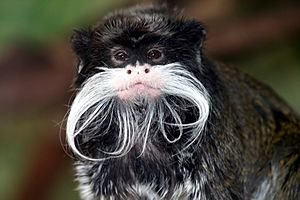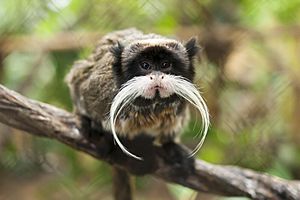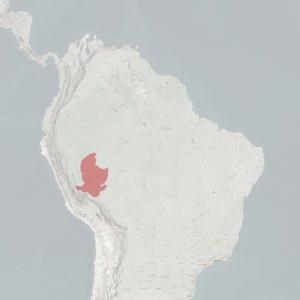Emperor tamarin facts for kids
Quick facts for kids Emperor tamarin |
|
|---|---|
 |
|
| S. i. subgrisescens at San Francisco Zoo | |
 |
|
| S. i. imperator at Dallas World Aquarium | |
| Conservation status | |
| Scientific classification | |
| Genus: |
Saguinus
|
| Species: |
imperator
|
| Subspecies | |
|
|
 |
|
| Range of the emperor tamarin | |
The emperor tamarin (Saguinus imperator) is a small, playful monkey found in the Amazon rainforest. It got its name because its long, white mustache looks a lot like the beard of a German emperor named Wilhelm II. These unique monkeys live in parts of northern Brazil, eastern Peru, and northern Bolivia.
Emperor tamarins have mostly grey fur with some yellowish spots on their chests. Their hands and feet are black, and their tails are brown. The most striking feature is their long, white mustache that sticks out past their shoulders. These monkeys are about 23 to 26 centimeters (9-10 inches) long, not including their tail. Their tail can be even longer, about 35 to 41.5 centimeters (14-16 inches). They weigh around 500 grams (about 1 pound), which is like a small bag of sugar!
Contents
What Does an Emperor Tamarin Look Like?
Emperor tamarins have sharp claws on all their fingers and toes, except for their big toe, which has a flat nail. Besides their famous long, white mustache, they also have tiny white hairs on their chin. Their chest and belly fur is a mix of red, orange, and white colors. The fur on their back is dark brown, and the inside of their arms and legs is a warm orange color.
These monkeys are quite small compared to many other primates. They use their claws to hold onto tree branches, staying upright as they move through the jungle. They are very quick and agile, leaping and moving through the trees in their rainforest home. They hardly ever go down to the forest floor.
Types of Emperor Tamarins
There are two main types, or subspecies, of emperor tamarins. They are the black-chinned emperor tamarin (Saguinus imperator imperator) and the bearded emperor tamarin (Saguinus imperator subgrisecens).
The bearded emperor tamarin (S. i. subgriscens) has more colors on its chest, belly, and arms. It also has a noticeable white beard, along with its long white mustache. The black-chinned emperor tamarin (S. i. imperator) only has faint black whiskers on its chin. Other than these small differences in color and their beards, both types of emperor tamarins look very similar in body shape.
Where Emperor Tamarins Live and What They Eat
Emperor tamarins mostly live in the Amazon rainforest. They prefer lowland and lower mountain rainforests. These areas are very humid and tropical all year round because of lots of water from nearby rivers. They also live in forests that have grown back after being cut down.
Their diet changes with the seasons. During the dry season, many plants flower, providing plenty of food. In the wet season, there are fewer flowers. They eat a variety of foods, including fruits and flowers from the plants around them. They also enjoy plant saps and gums, which they can easily get from trees. Sometimes, they hunt for insects and small frogs.
Emperor tamarins live in extended family groups, usually with 2 to 8 members, but sometimes up to 18. There is usually one main female who has babies. These groups often include only emperor tamarins. However, they sometimes join up with saddle-back tamarins to find food. Emperor tamarins usually stay high in the trees, above 10 meters (33 feet). Saddle-back tamarins tend to stay lower, below 10 meters.
When they hunt for food together, the smaller saddle-back tamarins are often faster at finding food. Emperor tamarins then follow them. They might use their larger size to encourage the saddle-back tamarins to move on from a food tree. This teamwork helps both species. It means more eyes are looking out for predators, keeping everyone safer.
Reproduction and Life Cycle
Emperor tamarins can start having babies when they are about 16 to 20 months old. A mother tamarin carries her babies for up to 6 months before they are born. They usually have babies during the wet season when there is plenty of food. This helps ensure the babies have enough to eat.
Emperor tamarins often have twins or even more babies at once! Because caring for many babies is a big job, the whole family helps out. In a group, one main female will have babies, and several males will help raise them. This way, many adults share the responsibility of carrying and protecting the young.
Older brothers and sisters, or other males in the group, act as "helpers." They carry the babies, which is very tiring because the babies are quite heavy compared to the adults. This extra help allows the mother to rest and find food. Male emperor tamarins are especially good at looking after the babies. They spend a lot of time carrying them and are very protective. They even react faster to a baby's cries for help than the females do.
The most dangerous time for young tamarins is when they are 5 to 15 weeks old. This is when they start to explore on their own. Falling from the trees is a big risk for them during this time.
Where Do Emperor Tamarins Live?
Emperor tamarins live in several South American countries. You can find them in Brazil, Peru, and Bolivia. They are mostly found in the southwestern part of the Amazon Basin.
Specifically, they live near several rivers, including the upper Purus river, between the Purus river and the Rio Acre, and east of the upper Juruá River. They also live near the Tarauacá River, Jurupari River, Urubamba River, Inajá River, and south of the Tahuamanu River.
The black-chinned emperor tamarin (S. i. imperator) is sometimes seen near the Rio Acre, and along the Purus River and Eiru River. The bearded emperor tamarin (S. i. subgrisescens) lives along the upper Juruá River and the Muyumanu River, south of the Tahuamanú river.
How Emperor Tamarins Behave
Emperor tamarins are very active, quick, and playful in the wild. They are also very social. In zoos, they often interact a lot with people. Studies have shown that within their groups, older tamarins tend to be more in charge. They communicate with each other using signals that show who is dominant and who is submissive.
Sometimes, there are disagreements, especially between young males or young females. These interactions help them figure out their roles in the group. Communication is super important for tamarins to stay together and work as a team.
Emperor tamarins also communicate with other monkey species, like saddle-back tamarins. Emperor tamarins are usually the dominant ones in these mixed groups. They use loud "long calls" that humans can hear from over 150 meters (about 500 feet) away. They make these calls when they wake up in the morning and throughout the day, especially when they are traveling or meeting other tamarin groups. These calls help different groups stay in touch.
The calls of emperor tamarins sound different from saddle-back tamarins, so both humans and other monkeys can tell them apart. Tamarins can even tell the sex of a monkey just by its call! These calls help them coordinate their movements and protect their territory.
Protecting Emperor Tamarins
The International Union for Conservation of Nature (IUCN) lists emperor tamarins as a species of "Least Concern." This means they are not currently in great danger of disappearing. However, their numbers have been decreasing.
The biggest threats to emperor tamarins are deforestation (when forests are cut down) and humans moving into their habitats. When forests are broken up into smaller pieces, it makes it harder for these tree-dwelling monkeys to move around. This can isolate groups of tamarins.
Emperor tamarins live in protected areas in Peru, like Manú National Park, and in Bolivia, like Manuripi-Heath Amazonian Wildlife National Reserve. Unfortunately, there are no protected areas that cover the emperor tamarin populations in Brazil.
Manú National Park in Peru is very important for protecting their natural home. It's one of the most biodiverse places in the world! Some local people live in the park and are allowed to hunt. This hunting mostly affects larger animals, but it has not had a big impact on the emperor tamarin population. In fact, research suggests that hunting might have even helped emperor tamarins spread to new areas.
The park also has successful ecotourism, where people visit to see nature. This helps the local communities. However, there is a concern that too much development for tourism could negatively affect the wildlife, including the emperor tamarins.
Emperor Tamarins and Humans
Zoos around the world observe interesting behaviors from emperor tamarins in captivity. For example, staff at the Jackson Zoo in Jackson, Mississippi, have noticed that their emperor tamarins seem to need a lot of gentle care. At the San Francisco Zoo, staff have reported that these monkeys often groom each other, which is a way they show affection and keep clean.
See also
 In Spanish: Tití emperador para niños
In Spanish: Tití emperador para niños


